| Reviews & Columns |
|
Reviews DVD TV on DVD Blu-ray 4K UHD International DVDs In Theaters Reviews by Studio Video Games Features Collector Series DVDs Easter Egg Database Interviews DVD Talk Radio Feature Articles Columns Anime Talk DVD Savant Horror DVDs The M.O.D. Squad Art House HD Talk Silent DVD
|
DVD Talk Forum |
|
|
| Resources |
|
DVD Price Search Customer Service #'s RCE Info Links |
|
Columns
|
|
|
Sidney Poitier Collection, The
THE MOVIE:
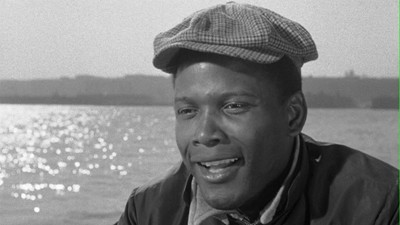
The cultural impact that Sidney Poitier had on cinema and society at large is indisputable. A dignified actor with a deep sense of social consciousness, he broke through racial barriers by choosing to play roles that shed the spotlight on intelligent black men--not perfect men, but men who lead their lives just like anyone else, with all the flaws that implies. Regardless of the role, Poitier refused to let any performance descend into racial clichés, and the example he created helped reshape the public perception of African Americans. It sounds frightfully simplistic, but such is the power of the moving image to shape the public perception. Roles in films like The Blackboard Jungle and The Defiant Ones forged Poitier's early reputation in the 1950s, and highly regarded turns in films like In the Heat of the Night, To Sir, With Love, and Guess Who's Coming To Dinner cemented his position as a cinematic icon in the 1960s. He would eventually direct, as well, and throughout his career, he would also accept the role of social activist. Still active to this day, he has been the Bahamian ambassador to Japan since 1997, and he published the book Life Beyond Measure - Letters to my Great-Granddaughter just this past year.
Warner Bros.' new boxed set, The Sidney Poitier Collection, brings together four little-seen films spanning fifteen years. Beyond that fact that Poitier was in each (and even directed one), the common theme of these films is the same as that of his career: challenging the odds by trying to live life as it is meant to be. As his character says in the earliest movie in the collection, 1957's Edge of the City, there are men and there are lower forms, and you can't let the lower forms push you into being anything less than the man that you are. (And given the respect Edge also pays to its female characters, one can assume he means "men" as in "humanity.")
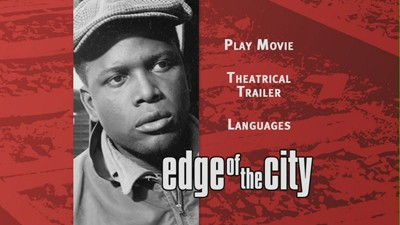
Edge of the City was the directorial debut of Martin Ritt, a politically motivated artist with a passion and fury to match Poitier's. (Ritt is probably best known for Hud, The Spy Who Came in from the Cold, and Norma Rae.) It also features John Cassavetes in the co-starring role, adding to the film's legacy as an early spotlight for maverick film artists. (Cassavetes is the prototype for the cantankerous independent American director.) The film opens with Cassavetes' character, Axel North (née Nordmann), rolling in to New York City with only a little money and a dubious recommendation in his pocket. The name he drops at the rail yard is of a man in San Francisco, but it's enough to get him a job under the crooked foreman Charlie Malick (Jack Warden). Knowing that Axel is on the lam, Malick puts the screws to him. He also doesn't like it when Axel befriends Tommy "T.T." Tyler (Poitier), the only black foreman on the yard. As the two become close, Charlie gets more upset and eventually pushes for Axel's secrets to come out.
The core of the movie, which was written by Robert Alan Aurthur (All that Jazz), is less about the past Axel is running from and more about how he learns to cope in the present. Tommy serves as a role model for the younger man. He's married and has a family, and his wife is an educated woman (Ruby Dee) who introduces Axel to an equally educated and socially active love interest (Kathleen Maguire). As Axel begins to trust Charlie, he is also given more strength to stand up for himself, to accept other people as they are, and accept whatever he may have done prior to NYC as something he can change. As far as male bonding goes, it's pretty healthy stuff. Cassavetes' twitchy method acting plays well against Poitier's upright performance, and Jack Warden rounds it out with smarmy menace. The climax where the two men must finally deal with this cranky thorn in their sides is maybe a little too On the Waterfront, but the gritty honesty of the writing up until that point allows Ritt to get away with it. A lot of the movie was shot on location, and so it has an on-the-street authenticity that prefigures French verite while also showing the influence of Jules Dassin's Naked City.
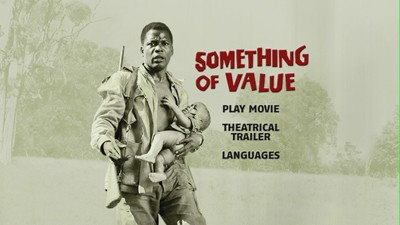
A year later, Poitier would shoot another movie about a friendship between a black man and a white man, but this time on the other side of the world and built on a completely different social dynamic. Something of Value re-teamed the actor with his Blackboard Jungle-director Richard Brooks, and it was based on a successful novel by Robert C. Ruark. The story is a fictional recreation of the Mau Mau uprising in Kenya in the early 1950s. Fed up with British rule of their country, a group of Kenyans fomented a violent revolutionary insurgency. In Something of Value, Poitier plays Kimani, a conflicted African who grew up side by side with the son of a white family but who starts to witness the adverse effects of British colonialism in his adult life. The first sign of this is the changing relationship between Kimani and his friend, Peter (Rock Hudson), whose father owns the land that Kimani's people have worked and who was raised by Kimani's mother after Peter's had died. The equality they felt as children is not as tolerated in the day-to-day of the grown-up world, and though both men recognize and dislike the change, they are beholden to it.
After Kimani's father is punished for following an admittedly barbaric tribal custom that conflicts with British law, it dislodges Kimani from his comfort zone. He runs away from home and joins a group of men that are essentially the early version of the Mau Mau. Reluctantly, Kimani enters the organization in full, meaning he will have to help steal guns and take action against the whites. The first attack is on part of Peter's family, and this puts the two men on either side of the divide in ways that transcend race--though Peter is determined not to let the situation stand. He joins the defense force in hopes of helping Kimani get out alive.
Something of Value has a loaded ideological narrative that some dramatists could easily have turned into a heavy bludgeon, but Richard Brooks, who also wrote the screenplay, largely avoids going overboard. Sure, some of the conversations about race are a tad simplistic, and Rock Hudson's moment of self-doubt passes a little too easily, but these end up being minor points. The characters are as complex as the situation, with no one being entirely right or wrong. Had Peter overcome his cowardice when his racist uncle (Robert Beatty) struck Kimani, it could have prevented things falling apart just as much as a greater understanding of local tradition might have kept Kimani's father out of a court ill-suited to his needs. And next to the obvious speechifying, there are also moments of surprisingly understated commentary. The most effective scene of racism receives no comment at all. Peter's family goes to talk to his fiancée Holly (Dana Wynter) about her upcoming nuptials, and they mock the marital practices of the native Kenyans, the seemingly innocent joke being far more indicative of the problem with colonialist attitudes than they could ever hope to realize.
Poitier is effective as Kumani, a conflicted personality heading toward a dangerous moral precipice. Both he and Hudson go a little overboard in trying to appear naive for the early scenes where the men are both younger, but as the film progresses, Poitier in particularl redeems himself in showing the tough decisions and the inner turmoil that makes Kumani's path difficult. Also of note is the performance of revered British actress Wendy Hiller (I Know Where I'm Going), who plays Peter's aunt. Her stoicism in the face of tragedy is inspiring, particularly given the harrowing attack on her and her family. Brooks shoots the violent mayhem in surprisingly gruesome detail. He also shows the later massacre of the Mau Mau in all of its brutality. Both sequences are heart wrenching.
There has been much made in recent years of Hollywood's liberal leanings, but movies like Something of Value remind us that cinema has always been a potent medium for social critique. It's always been the duty of our storytellers and artists to question the mores of their culture, as well as shed light on the painful wrongs that threaten our evolution as a people. It would be difficult in our day and age to look back at Something of Value and its message, which would now be closer to old fashioned values than to revolutionary liberal ideas, and suggest that the folks involved were uppity Hollywood types who were letting their fame go to their heads. It should stand as an example for the conscientious filmmakers of today to get their messages across without forgetting to also create solid drama. Richard Brooks even went so far as to get Winston Churchill to film an introduction to Something of Value, something that has been absent from most prints and, much to my chagrin, is absent from this DVD, as well. If my memory isn't playing tricks on me, I actually saw this prologue on the VHS version I rented a couple of years ago, which makes it all the more frustrating that it is not available here. All that remains is the Churchill quote that closes the picture.
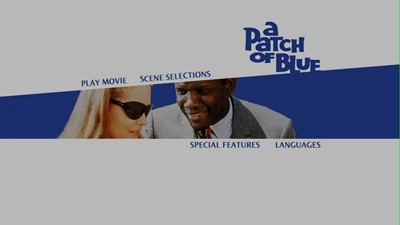
Things shift gears slightly with the third film in The Sidney Poitier Collection, 1965's A Patch of Blue. Though the actor's character was married in both previous films and Rock Hudson had a romantic subplot in Something of Value, A Patch of Blue is the first time we get to see Poitier in a love story in this set. Though, granted, it's a love story of a different kind.
Poitier plays career man Gordon Ralfe, who one day meets a blind girl, Selina (Elizabeth Hartman, Walking Tall), in the park. After sharing a conversation with her, he realizes that she has not been educated to get along on her own. In fact, as he will ultimately discover, she lives with her alcoholic grandfather (Wallace Ford, in his last role) and her equally drunk mother, Roseanne (Shelley Winters, who won her second Best Supporting Actress Oscar for her work). Despite the fact that Roseanne was the one who blinded her daughter, she holds the girl's condition against her and makes Selina work like a slave around the house. Until recently, when Selina started convincing her kindly boss (John Qualen) and her grandfather to take her to the park, the blind girl had barely been beyond her apartment. She has no idea how the world works for seeing people, much less for the sightless.
Selina also has no idea that Gordon is African American. Her only encounter with anyone of a different race was a young girl who lived in her building whom Roseanne forbad her to play with, though it was never explained to her why. Thus, amongst the many things that are beyond her, Selina has no concept of race or racism. Gordon, on the other hand, is far too aware of the judgmental glances he and the white girl receive when they are together. Even his brother (Ivan Dixon) raises concern at seeing the two hanging out, seeing only trouble for Gordon. Gordon does his best to keep his feelings in check, extending an honest helping hand to his new friend, but Selina falls for him immediately. She has never been shown kindness, it's only natural.
A Patch of Blue was written and directed by Guy Green, adapting a novel by Elizabeth Kata, and though the movie has strains of melodrama, he also balances that with a tough realism. Selina's squalid existence is full of cruelty and hatred, and Green does his level best to show what production standards at the time would allow. He even pushed the boundaries of those standards by filming an interracial kiss shared by Poitier and Hartman. Though these scenes were excised from a lot of prints at the time, particularly in more racially divided areas of the U.S., A Patch of Blue is intact on this disc.
The film manages to avoid getting too sappy, as Gordon keeps his head and makes the right choices for Selina, no matter how hard or bittersweet they may be. First-time actress Elizabeth Hartman rightly earned accolades for her portrayal of the blind girl. She is so convincing that I actually had to double-check that she wasn't blind in real life. Selina is an innocent in a harsh world, never entirely aware of the horrible things that have happened to her. Beyond the issues of race, Green seems to be indicting society more for its lack of compassion. How could Selina get through so much of her life without anyone ever extending a hand to aid her? The contrast between the world outside the apartment and inside is practically Dickensian, creating a sharp divide between the exploitative family relationship and the gentility of Gordon's care. The world outside the four walls of the apartment may still have its problems, but at least there is a possibility to advance.
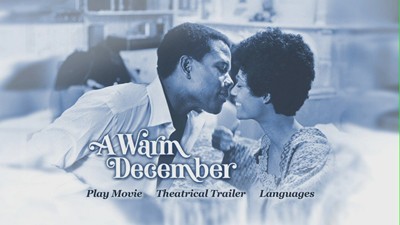
Sidney Poitier pulls double-duty for the 1973 clunker A Warm December, but I'm sorry to say it does nothing for his reputation as an actor or as a director. It's a poor way to round out this set.
When Dr. Matt Younger (Poitier) takes his daughter to London, he only hopes to get in a little dirt bike racing (yes, he races dirt bikes, and no, he's not twelve), but instead he becomes embroiled in what looks like a plot of international intrigue when the alluring Catherine (Esther Anderson) uses him as cover when men following her get too close. Catherine is an African dignitary, but her predicament is not a political one, it's medical. The espionage stuff is a feint, and after the pair have fallen in love, the script takes a different turn. Writer Lawrence Younger (A Kiss Before Dying) has crafted all of this hullabaloo about a pursuit so that we won't realize Catherine has a terminal illness until Matt has lost his heart to her completely. The back half of the film is a schmaltzy cram-in-as-much-romance-before-time-runs-out snoozer. Adding to the melodramatic wrinkles is Matt's status as a doctor (also a secret during the first act), so that he can agonize even more over the woman he can't cure.
Poitier's direction is completely lacking in style, and for an actor, it's surprising how little eye he seems to have for his cast's performances. Anderson is a nondescript love interest, almost completely lacking in the required mystery or charisma. This looks more like a TV movie than a big-screen effort.
As the conclusion to The Sidney Poitier Collection, whether you watch the films in chronological order (as I did) or in alphabetical order (as they are listed on the box), A Warm December is a jarring letdown. Thematically, it has little in common with the thoughtful dramas that precede it, tossing aside the big ideas and honest humanity for shallow, false emotions. It's not enough to sink the set, but it will likely only have the dust it gathers on your shelf shaken off when you pull out the other three movies for their repeat viewings.
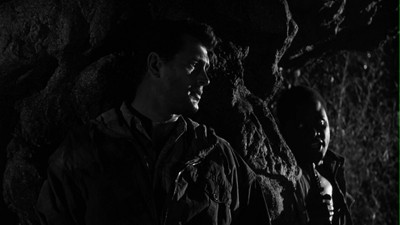
THE DVD
Video:
The four movies in The Sidney Poitier Collection have varying aspect ratios and technical specs, but they all have a solid base level to ensure decent DVD production. Though not perfect, the digital transfers are entirely passable and do at least improve as the age of the featured film decreases.
Edge of the City was shot at 1.37:1 ratio, and the anamorphic transfer features a clean black-and-white picture with only a small amount of damage. Some of the brighter scenes appear a little blown-out, with too much gray, but overall, there is a fairly decent tonal balance through most of the movie. Something of Value, though only a year younger, has a slightly sharper picture, and it maintains a consistent look throughout in terms of light and dark, but it also suffers from some soft edges and a handful of scenes that show scratches and debris. It was shot at a wider 1.85:1. I should also note that despite the packaging stating that Something of Value is in color--which really made my heart sink, especially since all of the pictures on the box are garishily colorized--the movie is in its original black-and-white, not some old Ted Turner color job. (Though I guess that would be kind of ironic for a film where the message is that color should not matter.)
The 2.35:1 print of A Patch of Blue continues the improvement, with very little evidence of film damage (only two instances stick in my memory) and a much better looking gray balance.
A Warm December is the sole film in color. Made in 1973, it has the somewhat muted, unnatural color palette of the time, as well as the expected graininess in the film stock. There were some slight tracers evident at times, but as with all the moves in the set, interlacing is not a problem.
Sound:
All of the features receive a monaural mix of their original English soundtrack, as well as a French dub and subtitles in both languages (except Warm December, which has the French subs but not the French audio). There is neither anything to shout nor complain about in regards to these soundtracks. They are clear and simply rendered, which is probably all they demand anyway. I didn't catch any problems with them, but they aren't going to light up your speakers with fireworks, either.
A Patch of Blue has an additional Spanish subtitle track.
Extras:
The level of extras varies from DVD to DVD, though all four of them come with their original theatrical trailers. In the case of Edge of the City, A Warm December, and Something of Value, the trailers are actually the only extras.
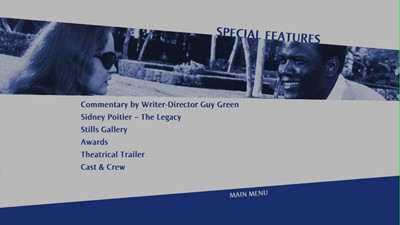
A Patch of Blue gets a handful of supplements, most of them text based: a special section on the accomplishments of Sidney Poitier, credits for other members of the cast and crew, and a list of awards the movie picked up. There is also a stills gallery.
Writer/director Guy Green has recorded an audio commentary for A Patch of Blue. It's a patchy track, with lots of pauses, but when Green does talk, he gives great details about the production (including on-set anecdotes), talking about the development of the story and how things varied from the original book and why. He also talks about some of the reactions to the film and dealing with censors. If you time it right, you can use some of the gaps in the monologue for multiple bathroom breaks and maybe to prepare a small meal.
Each movie comes in an individual slim plastic case, all four of which fit in one sturdy paper box.
FINAL THOUGHTS:
Three out of four ain't bad, and the three good movies in this boxed set are enough for me to give The Sidney Poitier Collection a rating of Highly Recommended. The taut black-and-white dramas that kick off the collection all feature thoughtful and sometimes fiery performances from the star, and each tackle various issues of race and getting along with excellent narrative skill. From the tough streets of New York in Edge of the City to the rough environments of Kenya in Something of Value, and back to the city streets of America where the divide between different neighborhoods echoes the divide between people in A Patch of Blue, all of these films are smart and emotionally effective. Not so much for the last feature, A Warm December, but it's not enough to weigh down an otherwise fine effort. I'd still have liked to maybe see a few more extras and the Winston Churchill intro on Something of Value, but the movies stand tall on their own despite these quibbles.
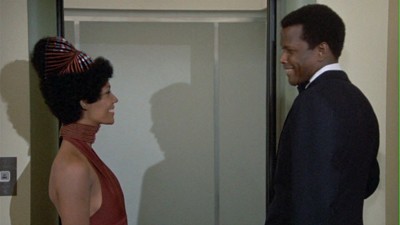
Jamie S. Rich is a novelist and comic book writer. He is best known for his collaborations with Joelle Jones, including the hardboiled crime comic book You Have Killed Me, the challenging romance 12 Reasons Why I Love Her, and the 2007 prose novel Have You Seen the Horizon Lately?, for which Jones did the cover. All three were published by Oni Press. His most recent projects include the futuristic romance A Boy and a Girl with Natalie Nourigat; Archer Coe and the Thousand Natural Shocks, a loopy crime tale drawn by Dan Christensen; and the horror miniseries Madame Frankenstein, a collaboration with Megan Levens. Follow Rich's blog at Confessions123.com.
|
| Popular Reviews |
| Sponsored Links |
|
|
| Sponsored Links |
|
|
| Release List | Reviews | Shop | Newsletter | Forum | DVD Giveaways | Blu-Ray | Advertise |
|
Copyright 2024 DVDTalk.com All Rights Reserved. Legal Info, Privacy Policy, Terms of Use,
Manage Preferences,
Your Privacy Choices | |||||||














